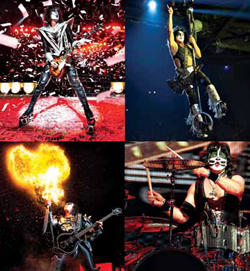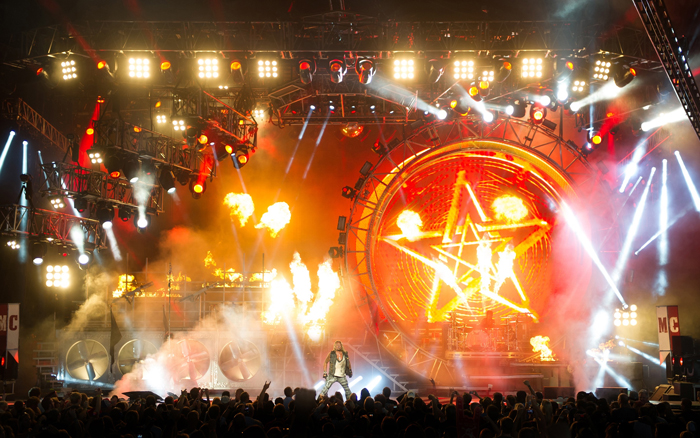
“Had we done this nine years ago we would have been hauling around four and a half trucks of sound instead of two and a half,” says Principato.
“The Clair StakRaks were instrumental in terms of us taking up a significantly smaller footprint,” he continues. “This business has become streamlined out of necessity.
“In the not-so-distant past we’d have had a stage left PA truck, a stage right PA truck, a front of house truck, and another truck for monitors and backline. Now we’re doing things with half of what we had before and it’s sounding bigger and better than it’s ever been.”
Joining Principato on the audio crew were Tripp Kahliff (front of house engineer/KISS), Dan Horton (monitor engineer/KISS), and Dave Ferritte (monitor tech/KISS).
On the Mötley Crüe side of the bill, beyond Andy Meyer at front of house, Harold Danker and Adam Stewart served as monitor engineers for Vince Neil and the rest of the band, respectively.
Opposites Attract
“There were two distinctly different approaches on this tour at front of house,” Principato pointed out.
“On one hand we had ‘Doctor Digital,’ and on the other we had ‘Captain Analog.’ Everything Andy did for Mötley Crüe was 100 percent AES digital, 96K from stem to stern, with all direction coming from a DiGiCo SD7.
“Across the aisle for KISS, you couldn’t have had more stark of a contrast. Tripp was 100 percent old school analog, everything was copper from where he sat to where the audience was standing. He was on a Midas XL4, and let me tell you he’ll live and die with that thing.”
Principato built two different snake systems to accommodate both approaches, with one going to the SD7 and the other to the XL4.
Using the Clair control software, both rigs were setup in an I/O configuration page, and according to the show’s needs, a simple push of a virtual button marked “ANALOG” or “DIGITAL” directed the proper signals to the PA.
When it came to monitors, wedges were a staple. Onstage for both KISS and Mötley Crüe, Clair SRMs took a bow in the footlights (along with the newer Clair CM22 for KISS drummer Eric Singer), as did four BT-218 subs placed behind Crüe drummer Tommy Lee for added presence in his in-ear monitors.

“There was a healthy combination of ears and wedges onstage,” Principato recounts. “Notably on the Mötley Crüe end of it, Tommy had ears, guitarist Mick Mars had ears and wedges, and lead singer Vince Neil had six wedges and side fills. He didn’t want to stick anything in his ears, not even others singing.
“KISS is pure old school in this department too. They just want to put the wood to it, that’s what they do. They all have ears, but their wedge configuration has never changed. Wedges are like a safety blanket for them.”
Downstage mics for KISS were hardwired, and yes, you guessed right: SM58s. The band’s guitars, however, went wireless, adding to what Principato and the rest of the crew said was a significant frequency coordination undertaking for both bands.
Known widely for his use of mics like a custom Sennheiser SKM 535 G2 shiny-ized in abstract patterns with Swarovski crystal beads, Vince Neil didn’t break with tradition this time out either, singing with his latest blinged-out vocal mic from the company’s U.S. headquarters in Connecticut.

